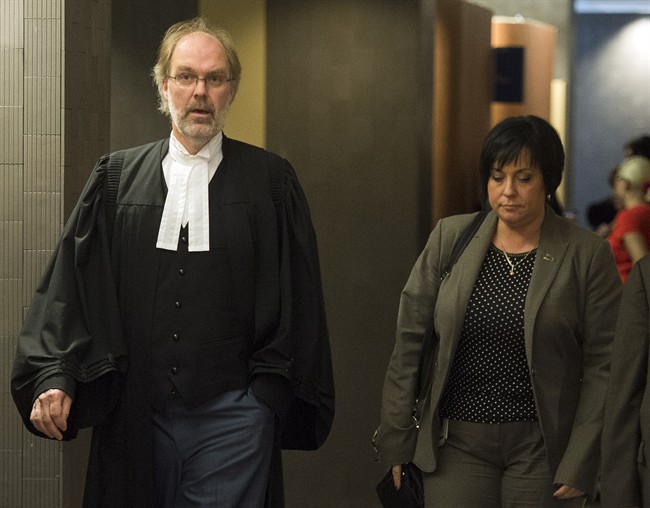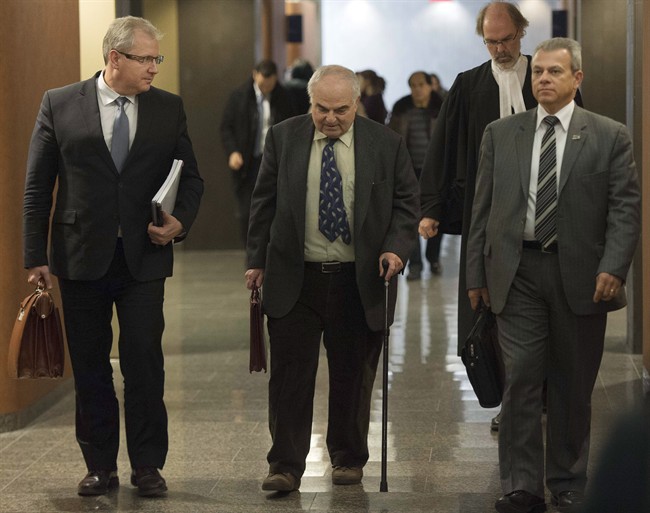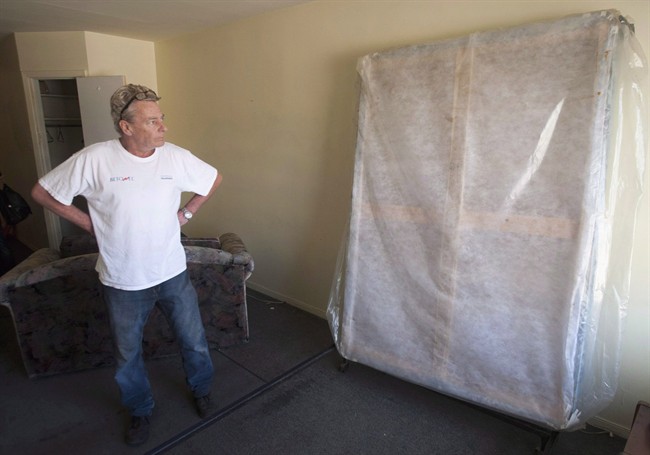Time is of the essence, the jury was told.

What did Luka Magnotta do after killing Jun Lin? Where did he go? Focusing on those details, surely, will confirm the killer was organized and in touch with reality, Crown prosecutor Louis Bouthillier told the jury during his closing arguments Thursday.
READ MORE: ‘Insanity is insanity,’ defence argues in closing arguments
And so the lawyer recounted, in the same precise detail the Quebec Superior Court heard throughout the 10-week trial, every movement Magnotta took from the moment he entered his apartment building with Jun Lin on May 24, 2012 until he left for Paris two days later.
Magnotta made multiple trips — 16 in total — to the garbage room, throwing out much of what Montreal police would later recover as evidence. He changed his outfit a number of times, checked out his reflection in the building’s lobby mirrors, ordered pizza, and made several trips in and out of the building.
READ MORE: Tracing Luka Magnotta’s footsteps, Part 1 of 3 The night Jun Lin is last seen alive
“And finally, at 5:14 p.m., it’s the last time the video cameras at 5720 Décarie Blvd. will catch a glimpse of Mr. Magnotta,” Bouthillier said.
- Budget 2024 failed to spark ‘political reboot’ for Liberals, polling suggests
- Train goes up in flames while rolling through London, Ont. Here’s what we know
- Peel police chief met Sri Lankan officer a court says ‘participated’ in torture
- Wrong remains sent to ‘exhausted’ Canadian family after death on Cuba vacation
That is when Magnotta hopped in a cab to Pierre Elliott Trudeau airport in Montreal to catch an Air Transat flight to Paris. He stayed there less than a week, losing out on several nights he’d pre-paid for a hotel room, to head to Berlin.
READ MORE: Tracing Luka Magnotta’s footsteps, Part 2 of 3 The making of a killer
Whereas Bouthillier recalled evidence already finely detailed throughout the trial, defence lawyer Luc Leclair on Wednesday told the jurors to disregard much of what they’d heard throughout the 40 days of testimony.
That, despite the fact his central witnesses — three psychiatrists who treated and assessed the defendant — all testified Magnotta was in a frenzied state of psychosis when he killed Lin, the consequence of schizophrenia.
GALLERY: Photos of Jun Lin, who was killed between May 24 and May 25, 2012.
Despite what forensic psychiatrists concluded, Bouthillier said, the jury should take into consideration other witnesses descriptions of Magnotta’s demeanor following the killing: knowledgeable, calm, cultured and well-groomed.
One German officer even said Magnotta was sitting with a grin on his face after being arrested, the Crown recalled.
Magnotta is charged with first-degree murder, committing an indignity to a human body, publishing obscene material, criminally harassing Prime Minister Stephen Harper and other members of Parliament and mailing obscene and indecent material.
READ MORE: Tracing Luka Magnotta’s footsteps, Part 3 or 3 The making of a killer
Although he admitted to the “physical acts” behind each charge, he is maintaining a plea of not guilty by reason of mental disorder.
Central to the jury’s decision is whether Magnotta was of sound enough mind to distinguish between right and wrong when he killed Lin.
In pleading its case, the defence focused on behaviours they’ve suggested are “out of touch with reality.” The Crown, meanwhile, zeroed in many of the same behaviours, telling the jury the actions prove awareness and pre-meditation.
READ MORE: Not criminally responsible myths, debunked
Standing at a lectern in front of the jury, Bouthillier was at the part of Magnotta’s timeline when the defendant left Paris for Berlin. This was on May 31 — seven days after he’d brought Lin home and two days after the victim’s torso was discovered in a suitcase.
“When he was identified by media as being wanted, as being in Paris, he fled quickly to Berlin to hide,” Bouthillier suggested to the 14-person jury. German police eventually arrested Magnotta on June 4.
Bouthillier then took a step back in time, to December 2011.
Five months before Magnotta killed Lin, he was in London. There, local reporter Alex West interviewed him about videos online purportedly showing Magnotta killing kittens.
Two days later, West’s newsroom received a menacing and vulgar email — long suspected, though only later confirmed, to have been penned by Magnotta.
READ MORE: Journalist describes meeting with ‘defensive and cocky’ Luka Magnotta in England
In it, Magnotta wrote he was behind the kitten-killing videos and had plans to move from little animals to humans. Moreover, he wrote of his intention to film the killing.
The grisly, repugnant video depicting Lin’s dismemberment and the indignities performed upon his corpse was played several times during his killer’s trial. For close to one minute of the video that quickly made the rounds online in the days following Lin’s death, there is footage of a man lying prone on Magnotta’s bed, bound to the metal mattress frame. That man, filmed between the night of May 18 and morning of May 19, isn’t Lin. Nor did police ever identify him.
READ MORE: Why is the court seeing Luka Magnotta’s gore video?
“I think this is important in showing the crime was planned,” Bouthillier said of the email to West. “In this email he said he was going to make a movie with a human. He started that movie on the 18, 19 of May, 2012. The first actor, unknown. And he ended the shooting of that movie on the 24, 25 of May, featuring Mr. Lin.”
Bouthillier recalled other actions Magnotta took, such as attempting to delete evidence of an email sent from his computer to a gore site containing a link to the snuff film, or apparently sullying the suitcase in which he stuffed Lin’s limbless torso.
“Why would someone do this?” Bouthillier asked the jury.
After a few breaths, he provided an answer to his own question: “Because they know right from wrong.”
GALLERY: The faces and places of Magnotta’s first degree murder trial.
Everything Magnotta did, from cleaning his drab bachelor apartment to switching hotels in Paris, from deciding to travel under an assumed name after arriving in Europe to deleting online accounts, from wrapping body parts in three layers of plastic to putting other peoples’ names on the parcels, all indicate the defendant was aware of what he was doing and prove he was trying to hide, Bouthillier said.
“Is this the action of someone who is delusional, who doesn’t know right from wrong?” he asked.
Then, as if to beat the jurors to an obvious question, Bouthillier noted Magnotta left tracks.
“He was sure to be found. Who in their right mind would do that?”
It’s not too difficult to imagine a world in which Magnotta would have gotten away, Bouthillier said.
READ MORE: Magnotta trial hears of discovery of victim’s severed head
Had one man not become curious about the suitcase lying in the sun for three and a half days, it would have soon been picked up and brought to the city dump. Same goes for the rest of the evidence collected from the garbage on the curb.
Had the drug store post office not had video cameras, Magnotta may not have been identified since he didn’t put his name on any of the parcels he mailed.
Equally important, Bouthillier said, was that a Toronto lawyer sent a fax to police leading to the discovery of Lin’s head more than two months after the killing.
“If not for those three events, there may have been no case against Mr. Magnotta,” Bouthillier said. “Police got lucky, Nadeau was curious and Mr. Magnotta made some mistakes.”
“People who commit first-degree murders or other crimes get caught when and if they make mistakes or if the police get lucky, or a combination of both,” Bouthillier said. “This is what happened here.”
The judge will issue his final instructions to the jury Monday, after which 12 or the 14 jurors will be sequestered until they reach a verdict.




































Comments